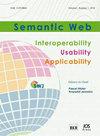Editorial of transport data on the web
IF 3
3区 计算机科学
Q2 COMPUTER SCIENCE, ARTIFICIAL INTELLIGENCE
引用次数: 2
Abstract
Whether you are planning your next trip abroad or want a package delivered to your doorstep, chances are high that you will need a chain of services provided by multiple companies. Transport is inherently a geographically and administratively decentralized domain composed of a diverse set of actors, – from public transport authorities to vehicle sharing companies, infrastructure managers in different sectors (road, rail, etc.), transport operators, retailers, and distributors. As a result, it suffers vast data heterogeneity, which, in turn, brings severe challenges to data interoperability. However, such challenges have also been posed in other domains such as the Internet of Things [18], agriculture [11], building data management [17], biology [7] or open data [2], which have found their solutions using semantic web technologies. However, despite several research contributions [6,14,19,23,25], public-funded projects1,2 or academic-industry events,3,4 we have not yet seen a wide adoption of semantic technologies in the transport domain. We may only guess the inhibitors for adopting Linked Data in this domain: i) the SPARQL query language is not built for optimal path planning, and ii) RDF is perceived as highly conceptual by industry experts. We argue that SPARQL does not fit well with the concerns that typically matter to route planners (e.g., calculating the optimal Pareto path [4]). While calculating a path with SPARQL is feasible through property paths, controlling the path planning algorithm, which can hardly be done in SPARQL, is the core concern of route planners. On the other hand, the transport domain is dominated by different standards (e.g., NeTEx,5 or DATEX II6) and vocabularies, which are based on legacy data exchange technologies (e.g., XML or RDB). However, to construct a distributed and scalable architecture that addresses the current needs of this domain, the Web and its associated technologies (i.e., the Semantic Web) are the key resource.在网上编辑运输数据
无论你是计划下一次出国旅行,还是想把包裹送到家门口,你都很有可能需要多家公司提供的一系列服务。交通运输本质上是一个地理上和行政上分散的领域,由不同的参与者组成,从公共交通当局到车辆共享公司,从不同部门的基础设施管理人员(公路、铁路等),到运输运营商、零售商和分销商。这就造成了数据的巨大异构性,给数据互操作性带来了严峻的挑战。然而,这些挑战也出现在其他领域,如物联网[18]、农业[11]、建筑数据管理[17]、生物学[7]或开放数据[2],这些领域已经找到了使用语义web技术的解决方案。然而,尽管有一些研究成果[6,14,19,23,25]、公共资助项目1,2或学术行业活动3,4,我们还没有看到语义技术在运输领域的广泛采用。我们只能猜测在这个领域采用关联数据的阻碍因素:1)SPARQL查询语言不是为最优路径规划而构建的,2)RDF被行业专家认为是高度概念化的。我们认为SPARQL不能很好地满足路线规划者通常关心的问题(例如,计算最优帕累托路径[4])。虽然SPARQL通过属性路径计算路径是可行的,但控制路径规划算法是路由规划者关注的核心问题,这在SPARQL中很难做到。另一方面,传输领域由不同的标准(例如,NeTEx、5或DATEX II6)和基于遗留数据交换技术(例如,XML或RDB)的词汇表主导。然而,要构建一个分布式的、可伸缩的体系结构来满足这个领域的当前需求,Web及其相关技术(即语义Web)是关键资源。
本文章由计算机程序翻译,如有差异,请以英文原文为准。
求助全文
约1分钟内获得全文
求助全文
来源期刊

Semantic Web
COMPUTER SCIENCE, ARTIFICIAL INTELLIGENCEC-COMPUTER SCIENCE, INFORMATION SYSTEMS
CiteScore
8.30
自引率
6.70%
发文量
68
期刊介绍:
The journal Semantic Web – Interoperability, Usability, Applicability brings together researchers from various fields which share the vision and need for more effective and meaningful ways to share information across agents and services on the future internet and elsewhere. As such, Semantic Web technologies shall support the seamless integration of data, on-the-fly composition and interoperation of Web services, as well as more intuitive search engines. The semantics – or meaning – of information, however, cannot be defined without a context, which makes personalization, trust, and provenance core topics for Semantic Web research. New retrieval paradigms, user interfaces, and visualization techniques have to unleash the power of the Semantic Web and at the same time hide its complexity from the user. Based on this vision, the journal welcomes contributions ranging from theoretical and foundational research over methods and tools to descriptions of concrete ontologies and applications in all areas. We especially welcome papers which add a social, spatial, and temporal dimension to Semantic Web research, as well as application-oriented papers making use of formal semantics.
 求助内容:
求助内容: 应助结果提醒方式:
应助结果提醒方式:


